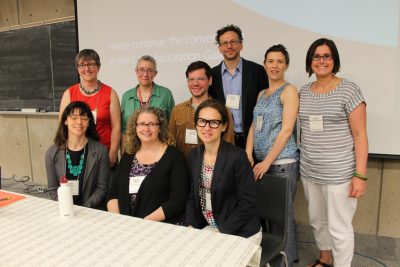by Mitchell White-Richard, CFICE Volunteer
Since the beginning of the Community First: Impacts of Community Engagement (CFICE) project, we have been working with our partners to study how to improve community-campus engagement partnerships. Community-campus engagement (CCE) can include community-based research, community service learning, and other community engagement activities.
Through this evaluation, CFICE has identified a number of elements that are key to the success of a community-campus engagement partnership. Here are the top 5:
- Setting Clear Expectations

CFICE Members planning together at a meeting. ©Jason Garlough
Because CCE projects can be complex, CFICE outlines the need to set clear expectations of what will be achieved and how it will be accomplished. If expectations are unclear CCE partners may have trouble understanding the purpose of their role in the collaboration.
It is therefore important that both parties begin their partnership by collaboratively setting the rules of engagement. This means identifying expectations, roles, responsibilities, limitations, and potential problems early on, and then continuing the collaboration with regular check-ins to make sure everyone is still on the same page. With clear expectations identified, the goals of all partners should be clearly understood so everyone can work towards achieving these goals
- Being Flexible and Equitable About Collaboration
Collaboration is the heart of CCE. By working together to identify issues within the community, CCE partners can develop potential solutions that build on the strengths of both academic and community contributions. But not all partners will have the capacity to contribute equally to the project as it progresses over time. This means that partners must take a flexible, “experimental” approach to navigating the partnership work while continuing to balance the partnership’s shared expectations.
- Engaging in Clear and Open Communication
Underpinning the ability to engage in a successful collaboration is the need for clear and open communication. Positive CCE partnerships are built on deep, communicative, and respectful relationships that develop based on honest, clear communication. Within CFICE projects, this type of communication and relationship development can be facilitated through working together in-person and virtually; supporting safe spaces for dialogue; and establishing a shared language.

Developing clear communication between all project partners helped the ANC Peterborough Project achieve its goals.
- Developing the Skills of Student Participants
While students often learn about community issues in the classroom, CCE and community service learning gives students the opportunity to apply what they learn in class and develop the necessary skills to address issues identified by communities. However, evaluation of CFICE projects has found that it can take a lot of time and energy for community partners to work with untrained students. Ensuring that students have at least some of the skills they need before participating in a CCE project can be a key factor in ensuring the success of the CCE partnership. This can be achieved by allowing community partners more control over the selection of RAs (so they can identify the students that have the skills the community needs), collaboratively working to set expectations for students’ role in the work, and providing sustained support and training to students over the course of CCE projects.
- Building in Time to Develop Long-term Relationships

Food Secure Canada has been a CFICE partner since the start of the project. ©Abra Brynne
Long-term relationships are important for the success of CCE partnerships, especially when they are developed while taking into consideration the elements listed above. Long-term relationships increase the depth of the research, the ability to accommodate complex projects, and the lasting impacts that can be achieved.
As CFICE discovered in Phase I, long-term relationships take time to develop. CFICE’s success as a project has ultimately depended on our ability to foster these relationships over the course of four years. And our continued success will only be achieved based on the relationships that we continue to build into Phase II. As we discovered, it is easier to develop projects in long-term relationships because the work of understanding each other’s expectations, developing trust, and building important skills has already been started.
Overall, many factors have been part of CFICE’s success in bridging together academic and community leaders through CCE partnerships. For more information on CFICE’s Phase I evaluations, please read through our Evaluation Backgrounder.